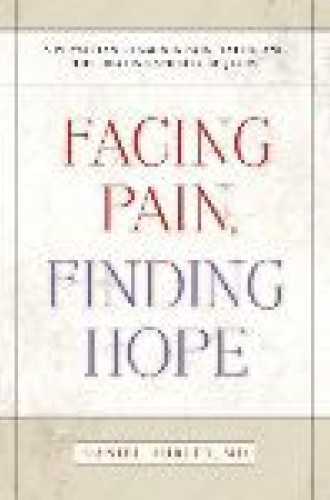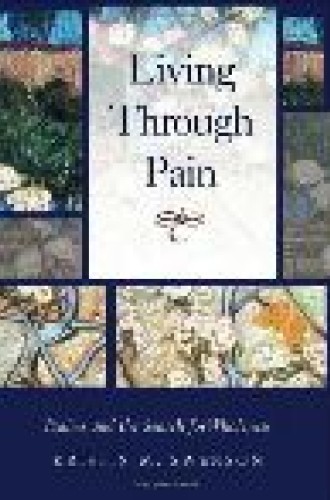Life-giving law
Virginia Woolf wrote in her essay “On Being Ill”: “English, which can express the thoughts of Hamlet and the tragedy of Lear, has no words for the shiver and the headache. . . . The merest schoolgirl, when she falls in love, has Shakespeare and Keats to speak for her; but let a sufferer try to describe a pain in his head to a doctor and language at once runs dry.” The fact that pain is resistant to language is no accident; indeed, acute or chronic pain can cruelly interfere with communication—even with the ability to speak at all. Sufferers are isolated from those around them by the very fact of their pain, which creates a burden of suffering distinct from the pain itself. And the medicalization of pain has cut off the experience of it from a distinctively religious view of suffering.
The authors of several new books understand that physical, emotional, psychological and spiritual pain are inseparable; they regard pain as a whole-person event. And a religious element underlies their quest for a holistic regard for individuals’ experience of and effort to cope with pain.
Kristin Swenson brings discussion on the nature of pain into conversation with the Psalms, in particular Psalms 2, 22, 38, 69, 88 and 102. They are “voices out of pain, not thought on pain or hypothetical ideas about pain management,” she says. “They represent a sense of self that is not neatly divided body from mind from spirit from community.” These Psalms, for Swenson, provide a vocabulary and grammar for understanding and expressing the real experiences of persons wrestling with pain, and they offer a model of a holistic suffering. Unlike curing, which returns a person to a former state of health, healing happens in any act of making whole. It involves the integration of the physical, psychological, spiritual and social. Swenson’s book is not about curing pain but, as the title promises, about living through pain.
Swenson admits that she does not know much about pain. This distinguishes her writing from that of Jeffrey Boyd, who has known deep personal and psychological suffering throughout his life and does not withhold this information from his reader. Instead, Swenson has learned about pain and suffering through the Psalms.
Although Swenson’s book is more biblical than Boyd’s, and about as biblical as Daniel Hurley’s, it is ironically less “religious” or theological than theirs. The greater irony is that even though Swenson is trained as an Old Testament scholar, she tends to be openly apologetic for sounding religious, which detracts from her thesis. The book does not make it out of the theological—and hence the spiritual—starting gate. Swenson describes the theology of these Psalms rather than elucidating the relationship between the various aspects of pain, which she tries nevertheless to bring into a whole.
In Facing Pain, Finding Hope, Hurley struggles theologically with the relationship between pain and faith by focusing on the biblical stories of Jesus’ healings. As a practitioner in physical medicine and rehabilitation, Hurley specializes in treating chronic pain, giving care to people without hope of recovery: people who are permanently paralyzed or brain injured, amputees, cerebral palsy patients, and victims of pain with a seemingly endless list of medical causes.
Hurley opens his book with a vignette that is illustrative of the book as a whole: kneeling to pray in the hospital chapel, Hurley, a practicing Catholic, looks at the crucifix and asks Jesus, “What do I learn from you, Lord? What do I bring from here over to my office where your suffering people wait?” In Facing Pain, Finding Hope he travels the distance between the chapel and the examining room, trying to integrate the first into the second.
Although spirituality doesn’t get much attention in the average interaction between doctor and patient, the majority of the scientific studies in this area indicate that patients and doctors believe spirituality to be an important aspect of healing and coping. Hurley thus struggles to connect his own work as a doctor with the “ultimate healing work of Jesus in the Gospels.” He weaves together with profound effect the stories of the gospel healings with composite stories of his patients as they cope with disability and pain.
Hurley describes pain as multilayered—tied to personality, psychology and social context as much as to biology. The layers can be seen as a set of four concentric circles. The first circle is the traumatic event that causes the pain. The second, larger circle is the neural sensation of the pain. The third circle involves the brain’s becoming aware of the painful event, and the fourth, which dwarfs the others, is called suffering.
Without employing Hurley’s imagery, Boyd discusses a fifth circle in Being Sick Well: the burden of suffering. How one receives and understands one’s suffering can create a burden on top of and beyond the actual pain of disease itself. Boyd also offers narratives of patients’ lives, attempting to show that there is a “triumphant minority of sick people who find a way to remain upbeat even during this earthly pilgrimage.” The narratives yield a number of strategies for coping with pain, suffering and loss of independence.
Being Sick Well carries two basic messages. First, there is a growing epidemic of chronic illness in the developed world. With new medicines and technologies, many diseases have become manageable chronic illnesses. But managing suffering has now become the problem. The second message of the book is that those who have lived joyfully with chronic illness can show others how to cope with pain and suffering and their many burdens.
The patients’ stories offer 20 strategies for coping with chronic illness. Rather that presenting a simplistic self-help list, Boyd comes to these strategies inductively, letting the patients show us from their own lives and struggles how the strategies work.
In my own suffering with chronic illness, I have come up with many of these strategies myself in my attempt to “be sick well.” I find that the most important are prayer, cultivating a social network (including going to church), using humor, taking one day at a time, exercising as much as possible, taking medicine as prescribed (which is more difficult than one might think), keeping busy and using the suffering itself to help others.
Boyd’s professional training makes him uniquely situated to write this book. Not only is he a medical doctor and head of psychiatry at Waterbury Hospital in Waterbury, Connecticut, he is also an ordained Episcopal priest with master’s degrees in public health and divinity. His multiple professional roles give him great insight into and sensitivity to the plight of people who suffer from chronic illness, particularly religious people. Although he also examines other spiritualities, such as Buddhism, Islam and even vague spiritualities of a “benevolent entity or power” without denigrating them, he tends to favor Christian practices. He points to 1 John 4:1-3—“Dear friends, do not believe every spirit, but test the spirits to see whether they are from God”—to underscore his contention that not every spirituality is going to be healing or is going to help sufferers to live fully.
Swenson’s Living Through Pain is a useful resource for pastors and parishioners studying suffering and the Psalms. Hurley’s Facing Pain would be helpful for a parish seeking to come to a richer understanding of Jesus’ healing miracles; parishioners may find studying it more fruitful than studying the usual historical-critical exegetical commentaries on the subject. Boyd’s Being Sick Well should prove particularly useful at the parish level, for Lenten study groups or other adult education classes. Facing Pain and Being Sick Well have great potential for building readers up in compassion for the sick and suffering, and I also recommend them highly for sufferers of chronic illness and for their families, pastors and caregivers.






